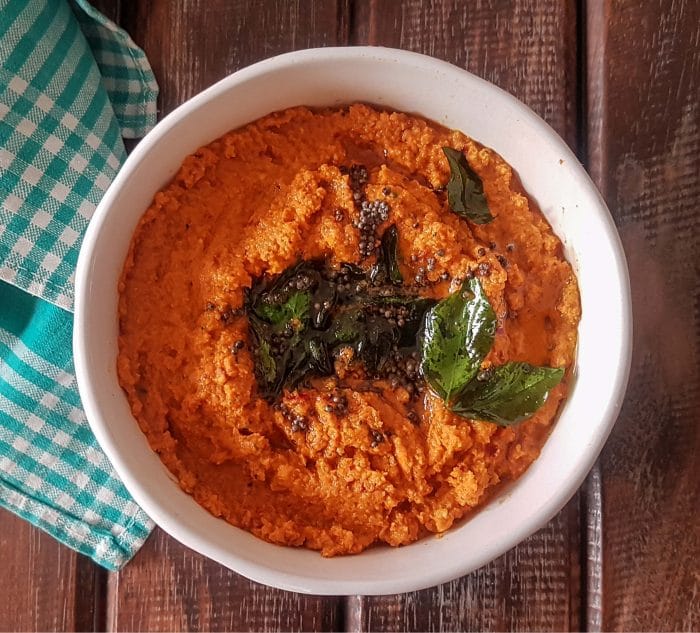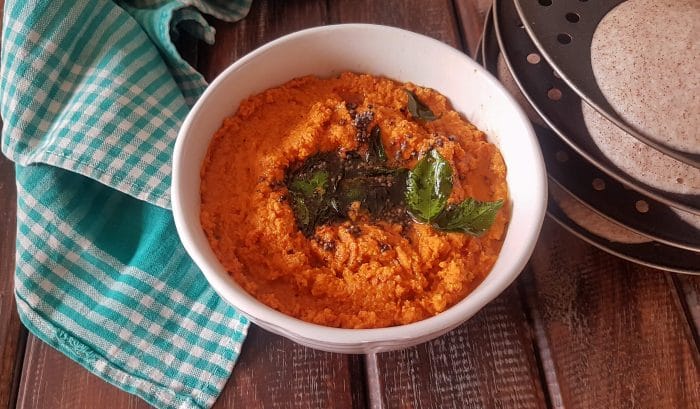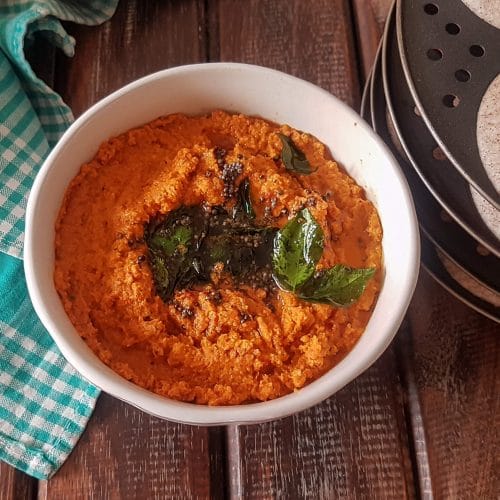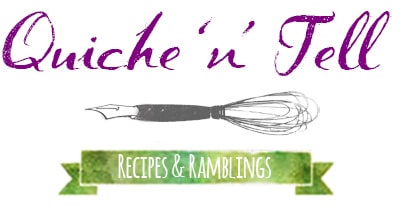This carrot thogayal recipe was shared by a dear friend’s mother, who has a vast repertoire of thogayals in her culinary quiver. Thogayal or thuviyal is essentially Tamil for chutney. Thick and on the drier side, it has similar versions in Kerala known as chammanthi and thokku in Andhra.
This particular carrot thogayal is typical of the cuisine of the Iyer community of Palakkad; Tamil brahmins who migrated to this verdant, predominantly agricultural part of Kerala. Their pure vegetarian food (without onion and garlic) is a delightful melange of typically Malayali ingredients cooked in their signature Iyer way. Coconut, ash gourd, elephant’s foot yam, colocasia root, bitter gourd, pumpkin, string beans, jackfruit, nendran bananas are just a few of such ingredients. Being strict vegetarians, their food makes up for the lack of meat, fish and eggs with the generous use of a large variety of vegetables and pulses (dals) which are enriched with spices and chillies (but the heat here, unlike Andhra food is moderate).

What is a thogayal?
Coming back to the carrot thogayal, it must be said that thogayal style of thick chutneys are normally eaten with steamed rice and molagootal – a thick, coconut and pigeon pea (tuvar or toor dal) based vegetable curry flavoured with a paste of skinned black gram (urad dal) cumin seeds, red chillies, curry leaves etc. It’s a favourite combination along with pappadums and fried chillies I’m told.
The thogayal is simple enough to make and it gave me another option for a chutney. I have a soft corner for South Indian pachadis and chutneys because they use a large variety of vegetables, even their peels sometimes, in interesting, delicious ways.These are versatile enough to be eaten with plain rice as well as with idlis, dosas, uttapams, vadas, pesarattu etc. I’ve even used my Andhra-style radish pachadi as a dip at dinner parties with great success. I served the carrot thogayal with ragi idlis for breakfast and it hit the spot. Give me a good, old South Indian breakfast any day, any time; I never tire of it.

The main ingredients
In the carrot thogayal, fresh, grated carrots and fresh coconut (more carrots though) add mild sweetness. Dried red chillies add a dash of heat, small amounts of dals help build a thick, nutty base, tamarind brings a zing of acid and hing or asafoetida infuses the mixture with its unique, deeply aromatic umami. Asafoetida is the x-factor in many Indian dishes – it’s an ingredient that must be added in just the right amount to build that ‘fifth’ flavour; overdo it and the dish can become indelibly pungent. Most Indian home cooks like me, don’t measure the quantity of hing, relying more on our instinct, which has been honed over years of cooking meals for the family. Our mothers and grandmothers couldn’t think in terms of teaspoons since they never learned how. But for the purposes of recipe-building though, one has to quantify approximate quantity and so I did.
I’ve written an entire post on this simple, everyday dish but the best way to appreciate is by cooking it and adding it to your table.

Carrot Thogayal
Ingredients
- 3 medium carrots, grated
- 4 tbsp fresh coconut, grated
- 4-5 dried red chillies, use fewer if they're very hot ones
- 2 tbsp chana dal or split Bengal gram
- 1 tbsp urad dal or skinless black gram
- 2 tbsp thick, tamarind pulp (soak a walnut-sized ball of tamarind in hot water for 20 mins to extract the pulp)
- ¼ tsp hing or asafoetida powder
- 1 tsp mustard seeds
- 12 fresh curry leaves
- 2 tbsp gingelly oil or any other vegetable oil
- Salt
Instructions
- Heat 1 tbsp oil in a pan on low heat and gently toast both the dals followed by the red chillies for a min. Add the asafoetida, carrots, tamarind pulp and half the curry leaves and cook till the carrots are soft but not watery and mushy.
- Cool the mixture and then grind together with the coconut and salt using a little water till you get a coarse, thick chutney.
- Transfer the thogayal to a bowl. Heat a pan with the remaining oil and add the mustard seeds and remaining curry leaves o the hot oil. Allow them to crackle. Pour the tempering over the thogayal, mix well and taste to add a little more salt if needed. The thogayal can be stored in an airtight glass or ceramic container and will keep in the fridge for a couple of days.





No Comments